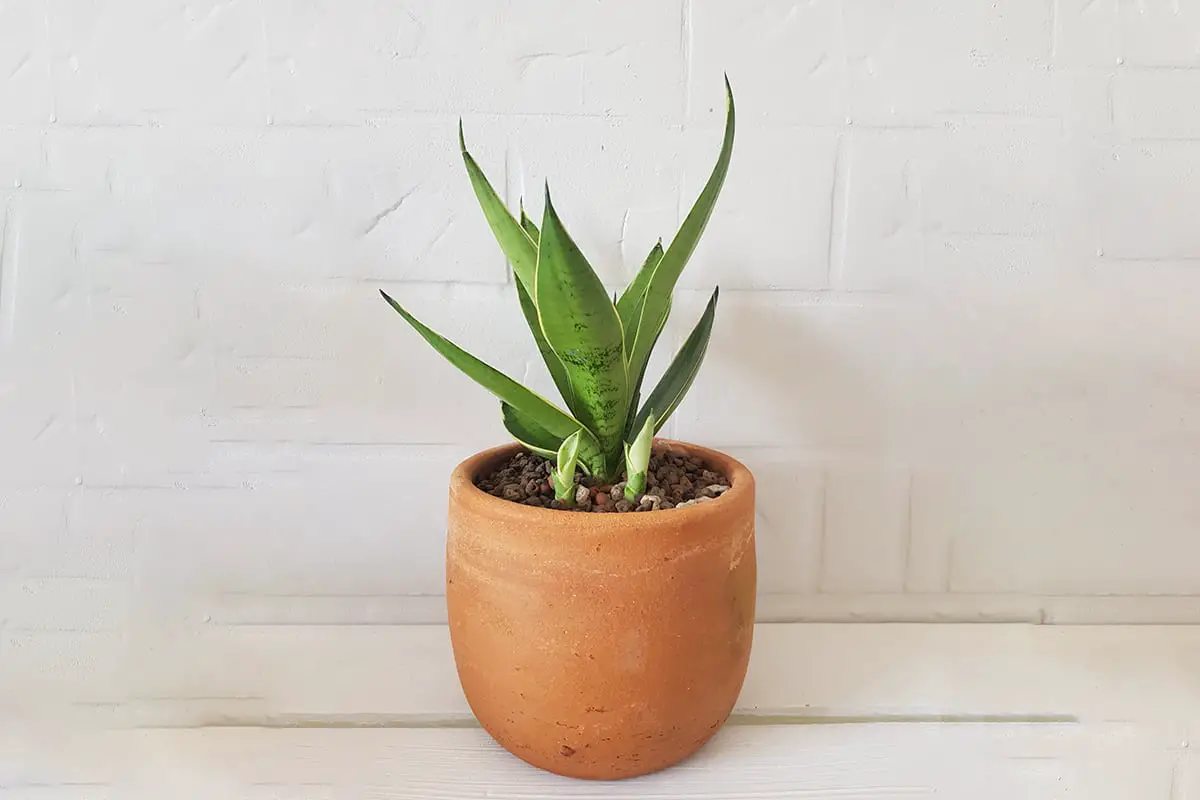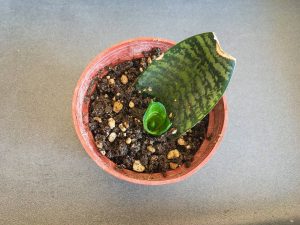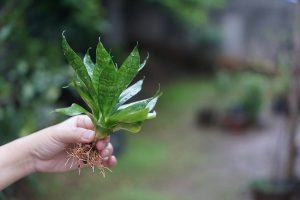This unusual snake plant is one you may not have seen before, and that’s because it’s a fairly new variety. The Night Owl Snake Plant does not grow in the wild and is actually a cultivated hybrid that is a result of crossing the Sansevieria trifasciata Laurentii with the Sansevieria trifasciata Hahnii (better known as the Bird’s Nest Snake Plant’.)
The product of the hybridization is a low-growing type of snake plant, which mimics the growth patterns of the Bird’s Nest Snake Plant, sending out the foliage in a cup-like shape but with more unusual coloring.
You would be forgiven for thinking that this hybrid was created by crossing the Bird’s Nest Snake Plant with the Moonshine Snake Plant because the color of the foliage is a pale gray-green, just like the leaves on the Moonshine. If you are lucky enough to get your hands on one of these new snake plants, follow these guidelines to ensure it lives a long and healthy life.
| Botanical name | Sansevieria trifasciata Night Owl |
| Common names | Night Owl Snake Plant |
| Plant family | Asparagaceae |
| Mature height | 16 inches |
| Mature spread | 10 inches |
Table of Contents
How to Care for a Night Owl Snake Plant
The Night Owl Snake Plant is very easygoing compared to many other types of houseplants, and in fact, snake plants are often hailed as ‘indestructible’. While this plant will adapt to a variety of conditions, you shouldn’t take this for granted. Here we look at the ideal growing conditions for the Night Owl Snake Plant.
Light
Snake plants, in general, will grow in any type of light, from shade to bright direct light and everything in between. You can keep the Night Owl Snake Plant in low light if you wish, but you might notice that the coloring on the foliage becomes duller, darker, or less distinctive. Since the interesting variegation and pale coloring on the leaves is one of the most interesting things about the Night Owl Snake Plant, it would be a shame to lose it.
It’s also worth noting that if your plants’ leaves turn darker and lose their pale green coloring, you won’t be able to get them back again. Once the transition to darker or duller green has been made, the result is permanent.
At this point, all you can do is give your plant more light to ensure that future growth is the pale green color it is supposed to be. Ideally, you will avoid this entire scenario by positioning the Night Owl Snake Plant in a brightly lit spot from the start.
These plants will thrive in bright, indirect light, but they can also tolerate direct sunlight if you introduce them to it gradually, starting at just a few hours a day and working your way up.
Soil
Growing your Night Owl Snake Plant in appropriate soil will make your plant care journey much easier. These plants need light soil with good aeration that allows the roots to breathe, and it also needs to drain well so that the roots don’t rot.
If your snake plant is grown in heavy, dense, compacted soil, the roots won’t be able to breathe, and the water won’t be able to drain. This is going to cause a number of problems going forward, and you will always be fighting against the improper soil until you give in and decide to repot the snake plant in more appropriate soil.
Avoid this drama and select a potting mix intended for succulents and cacti from the start, or create your own well-draining potting mix. You can add a small amount of compost to the mix if you want to boost nutrition, but this isn’t necessary since Night Owl Snake Plants don’t have high nutrient requirements.
Compost does tend to make the soil hold on to moisture for longer, so if you want to add compost to the mix, make sure you do so sparingly.
Water
Night Owl Snake Plants have low water needs. The biggest killer of snake plants is overwatering, so refrain from watering to a set schedule and instead listen to what the soil around your snake plant is telling you.
By testing the soil to feel for moisture, you will know if your Night Owl Snake Plant needs to be watered or if it needs to be left alone. You can lift the plant up and check the soil through the drainage holes at the bottom, or if you don’t mind getting your hands dirty, you can dip a finger into the top of the soil. Any hint of moisture means the plant does not need to be watered yet.
Temperature
Night Owl Snake Plants perform best in temperatures ranging from 65 to 85°F. However, they can stay alive in temperatures ranging from 50 to 100°F for short periods of time. If your Night Owl Snake Plant is being kept outside, be sure to bring it indoors as soon as temperatures start to consistently dip below 60°F. It is sensitive to frost, and remaining in low temperatures will kill the plant. When grown as a houseplant, the Night Owl Snake Plant will be comfortable as long as you are comfortable since they prefer similar temperatures to people.
Humidity
Snake plants come from West Africa, where the air quality can vary from dry to humid. This means that snake plants fare well in most types of air, so you won’t need to take any special measures to alter the level of humidity in your home or garden for the Night Owl Snake Plant.
Fertilizer
Night Owl Snake Plants don’t need to be fertilized because they have low nutritional needs. You can actually cause more harm than good by fertilizing snake plants because denying them of fertilizer won’t cause any issues, whereas too much fertilizer can cause fertilizer burn.
If you feel strongly about providing fertilizer to your plants, choose a fertilizer designed for succulents, and use it sparingly. If in doubt, resist the urge to fertilize the snake plant.
Repotting
Night Owl Snake Plants rarely need to be repotted for three reasons. The first reason is that these are slow-growing plants, and slow-growing plants don’t outgrow their pots for many years. The second reason is that the root system of the Night Owl Snake Plant is quite small and weak, so repotting it is usually unnecessary and puts the delicate roots at risk of damage.
The third reason is that when grown in their native habitat, snake plants have roots that have to survive on hardy, rocky ground, where there is very little opportunity to spread or grow. As a result, snake plants have adapted their root systems to thrive in tight, harsh conditions.
Although the Night Owl Snake Plant is a hybrid cultivar, it has inherited the care requirements of its parents, so it prefers to be root bound and will rarely, if ever, need to be repotted. You should avoid repotting the Night Owl Snake Plant until the pot is overrun with new growth and pups emerging from the surface of the soil.
When you do repot the plant, choose a container only an inch or two bigger than the one you were using. Pots which are a lot bigger than the root system are bad for the plant because they will overwhelm the roots with too many nutrients, and they will hold onto water for longer than a small pot.
Night Owl Snake Plant FAQs
What is the best pot for a Night Owl Snake Plant?
When kept as a houseplant, you should grow the Night Owl Snake Plant in a plastic pot with drainage holes and then set it inside a more decorative pot if you want it to look pretty. Using a pot liner like this will ensure water can drain away freely, helping to prevent overwatering and root rot.
Plastic pot liners also enable you to lift the plant up and check the bottom layer of soil through the drainage holes. When grown outside, a terracotta pot is best for all types of snake plants because these are porous and will absorb excess water and help it to evaporate. In terms of the size of the pot, Night Owl Snake Plants like to be root bound, so keep them in containers they fit tightly into.
How big do Night Owl Snake Plants get?
This hybrid cultivar is a compact snake plant that reaches ultimate heights of up to 16 inches. Though this might sound quite sizable, it is much smaller than most other types of snake plants, making it well suited to life on a desk or shelf.
The plant can spread up to 12 inches wide, or the equivalent of 1 foot. As quite a slow-growing plant, it can take anywhere from 5 to 10 years for the Night Owl Snake Plant to reach its expected mature size. It will grow faster in brighter light compared with shade.






